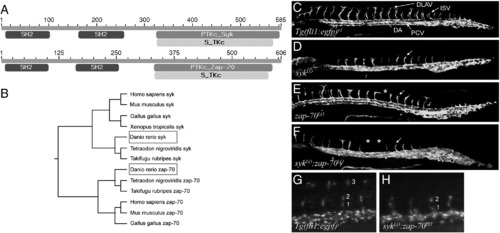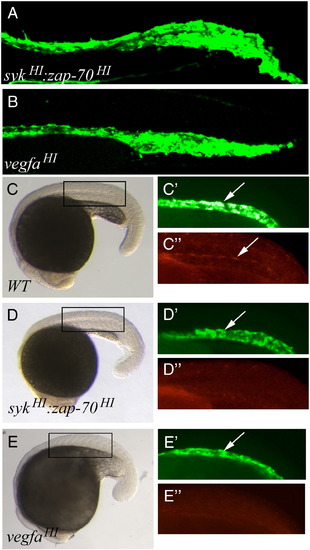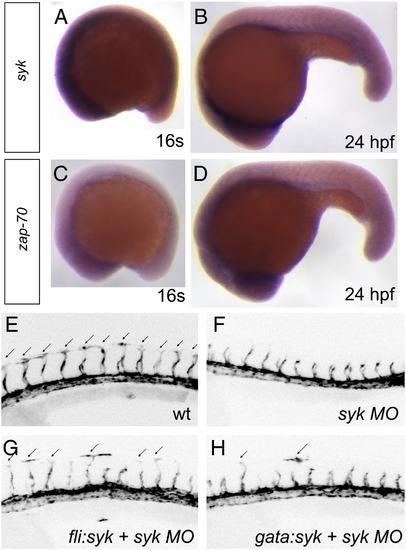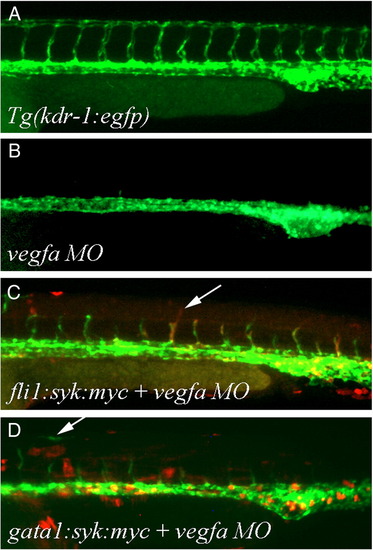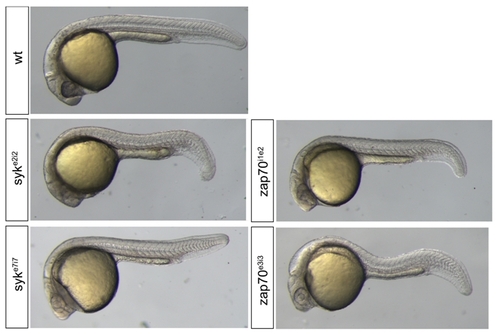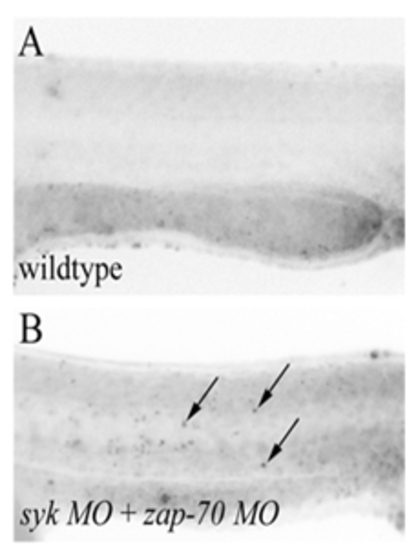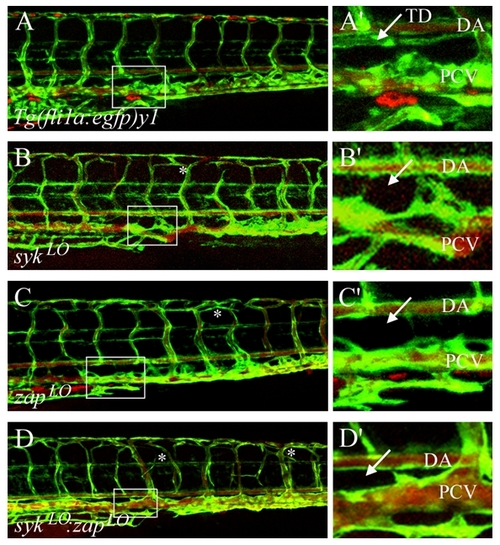- Title
-
Syk and Zap-70 function redundantly to promote angioblast migration
- Authors
- Christie, T.L., Carter, A., Rollins, E.L., and Childs, S.J.
- Source
- Full text @ Dev. Biol.
|
The zebrafish orthologs of syk and zap-70 mediate angioblast migration to form the ISVs. (A) Zebrafish syk and zap-70 have similar domain structures with N-terminal SH2 domains, and a C-terminal tyrosine kinase domain (PTK). (B) Alignment of the nucleotide sequences of syk and zap-70 with orthologs in other species shows a clear grouping of zebrafish syk with the other syk orthologs, and zap-70 with the other zap-70 orthologs. (C) At 30 hpf, ISVs in Tg(fli1a:EGFP)y1 embryos have reached the dorsal aspect of the somite and are contributing to the DLAV in wild-type embryos. (D?E) Injection of a low dose of syk morpholino (sykLO, D) or zap-70 morpholino (zap-70LO, E) results in delayed (arrows) or completely suppressed (asterisk) angioblast migration to form the ISVs. (F) Co-injection of low doses of both morpholinos results in a more severe stalling and suppression of angioblast migration (sykLO:zap-70LO). (G?H) Tg(fli1a:EGFP)y7 embryos with endothelial-expressed nuclear GFP show fewer cells in the ISVs of sykLO:zap-70LO embryos. Anterior is to the left in all embryos. DA: dorsal aorta; PCV: posterior cardinal vein; ISV: intersegmental vessel; DLAV: dorsal longitudinal anastomotic vessel; hpf: hours post fertilization. PHENOTYPE:
|
|
sykLO and zap-70LO morphants display late stage ISV patterning defects. (A) The trunk of 5 dpf wild-type Tg(fli1a:EGFP)y1 embryos display regularly patterned ISVs between somites, with the dorsal-most ISV endothelial cell forming a clear T shape and contributing to the DLAV. In contrast, 5 dpf sykLO (B), zap-70LO (C), and sykLO:zap-70LO (D) morphants display abnormal ISV vasculature with mild patterning defects. The ventral stalk ISV endothelial cell is relatively normal, and the dorsal T-cell still contributes to the DLAV, but the branching of the cell into the T shape is abnormal (asterisks) and can occur as ventrally as midsomite (arrows). These dorsal patterning defects are more pronounced in the sykLO:zap-70LO morphants. PHENOTYPE:
|
|
sykHI:zap-70HI morphants resemble vegfa morphants and lack activated ERK. (A) sykHI:zap-70HI Tg(fli1a:EGFP)y1morphants have a complete suppression of ISV sprouting which is phenotypically similar to the ISV stalling observed in high dose vegfa morphants (B). While the artery of 20s wildtype (WT) embryos (arrow, C′) shows activated ERK (arrow, C″) comparable staged sykHI:zap-70HI morphants (D) show a strong downregulation of activated ERK (arrow D′ = artery, D″). The level of downregulation of activated ERK in the artery (arrow, E′) is similar to vegfaHI morphants (E, E″). C′, D′, E′ are enlargements of GFP signal in the boxed region of C, D, E, respectively. C″, D″, E″ are enlargements of the αERK-P immunohistochemistry in the boxed regions of C, D, and E respectively. EXPRESSION / LABELING:
PHENOTYPE:
|
|
syk rescues angioblast migration defects after syk knockdown. (A?D) syk and zap-70 are expressed in a ubiquitous manner and have overlapping expression profiles. At 16 somites (16s) syk (A) and zap-70 (C) are highly expressed in the head, with low levels of expression throughout the rest of the embryo. (B, D) By 21s increased expression is seen in the ventral trunk. (E?F) By 30 hpf, the ISVs of wildtype Tg(fli1:egfp)y1 embryos have reached the dorsal portion of the embryo to form the DLAV (E) while the ISVs of syk morphants are delayed at the mid-trunk (F). (G?H) Expression of a C-terminal myc-tagged syk in the vasculature (G, fli1:syk:myc) or blood (H, gata1:syk:myc) partially rescues the number of ISVs that have reached the DLAV (black arrow). EXPRESSION / LABELING:
PHENOTYPE:
|
|
Endothelial and vascular expression of syk rescues angioblasts migration in vegfa morphants. (A?B) Compared to 30 hpf wildtype Tg(fli1:egfp)y1 embryos with complete ISVs (A), vegfa morphants lack any ISV sprouting (B). (C?D) Expression of a C-terminal tagged syk under the control of a vascular fli1 promoter (fli1:syk:myc, C) or a blood gata1 promoter (gata1:syk:myc, D) in single celled embryos injected with 4 ng of vegfa morpholino results in increased number of ISV sprouting (white arrow). Expression of the fli1:syk:myc construct is detected by immunohistochemistry against the myc tag (red, C, D). The large myc-expressing cells visible in the dorsal and mid-trunk of gata:syk injected embryos are superficial and do not represent expression of the transgene in blood vessels, while ventral myc expression cells are within the axial vessels. PHENOTYPE:
|
|
Quantification of morpholino efficiency |
|
Phenotype of syk and zap-70 morphants at 24 hpf. |
|
sykLO:zap-70LO double morphants have fewer endothelial cells in their axial vessels at 30 hpf. The number of endothelial cells in axial vessels was enumerated in the region below 10 ISVs of the trunk of Tg(fli1a:nEGFPy7) uninjected (n= 50 ISVs) or sykLO:zap-70LO double morphants (n= 70 ISVs) at 30 hpf. Error bars represent standard deviation. PHENOTYPE:
|
|
Acridine orange shows low off-target cell death in sykLO: zap-70LO double morphants. (A) Acridine orange staining of 30 hpf wildtype embryos shows few acridine orange positive cells. (B) Staining of 30 hpf sykLO: zap-70LO double morphants shows a small increase in acridine orange positive cells (arrows), though not in regions associated with endothelial cells. |
|
Syk and Zap morphants lack a thoracic duct. Angiography in wild type Tg(fli1a:EGFP)y1 embryos shows a clear separation between the dorsal aorta and posterior cardinal vein, and the presence of the thoracic duct lacking dye between the two vessels (A, A′). Conversely, angiography in sykLO (B, B′), zap-70LO (C, C′), and sykLO:zap-70LO double morphants (D, D′) demonstrates the clear lack of a thoracic duct between the artery and vein. In sykLO:zap-70LO double morphants, some ISVs also appear to have restricted or lack blood flow. PHENOTYPE:
|
Reprinted from Developmental Biology, 340(1), Christie, T.L., Carter, A., Rollins, E.L., and Childs, S.J., Syk and Zap-70 function redundantly to promote angioblast migration, 22-29, Copyright (2010) with permission from Elsevier. Full text @ Dev. Biol.

